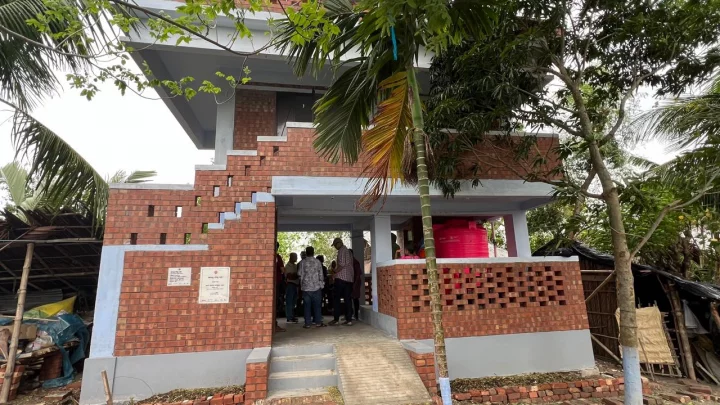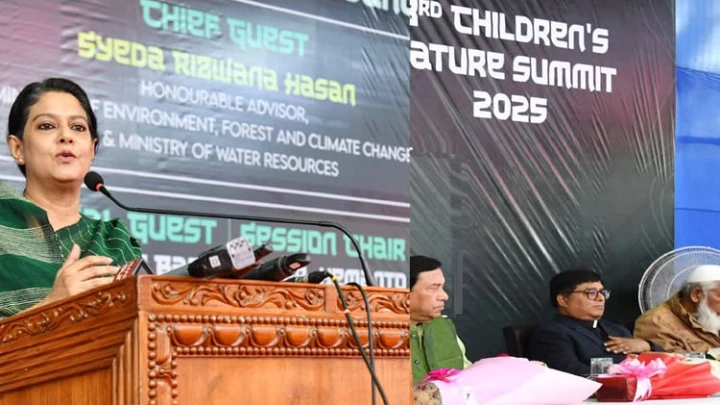How climate-resilient houses saved hundreds in coastal regions
DhakaTribune || Shining BD
When Cyclone Remal struck Bangladesh, 23-year-old Shwati Baroi from Mongla upazila of Bagerhat was visiting her mother’s house, bringing along her newborn baby from her in-laws' residence in Narail.
While the cyclone was wreaking havoc in Bangladesh last week, Shwati, her baby and her mother took shelter in a nearby climate-resilient house in Joy Kha village, Sonailtala union, Mongla.
They remained safely in the house-cum-mini cyclone shelter throughout the entire period of Cyclone Remal. Several other families, also caught in the cyclone's rampage, stayed with them.
Not only Shwati, but more than 1,000 people from 183 families took shelter in the 36 climate-resilient houses – called “Amar Ghor Amar Ashroy” – across the coastal areas of the country during the cyclone.
The climate-resilient houses, designed by Brac and later adopted by the government, have yet to be officially inaugurated, but people are already utilizing them, having come by significant support during the recent cyclone, which caused extensive damage in the coastal areas of Bangladesh.
While speaking with Dhaka Tribune after the cyclone, Prova Mridha, the owner of one of the houses, said these climate-resilient houses were not like a typical cyclone shelter.
“This two-storey house is our home year-round. The ground floor is dedicated to our cattle and household resources, while the first floor is for us. The first floor has two separate rooms for use during disasters: one for men and one for women. The washroom facilities are very convenient, and the building has a built-in solar system.
 The image shows resilient house, specially designed for vulnerable populations to address climate-induced disasters and long-term changes resulting from climate change, in Mongla. Photo: Ali Asif Shawon/Dhaka Tribunen
The image shows resilient house, specially designed for vulnerable populations to address climate-induced disasters and long-term changes resulting from climate change, in Mongla. Photo: Ali Asif Shawon/Dhaka Tribunen
“My family, neighbours and I were safe in this climate-resilient house without facing the hassles we would encounter at typical cyclone shelters."
Officials familiar with the project said the coastal regions of Bangladesh were highly vulnerable to climate change due to their low elevation and proximity to the Bay of Bengal.
Rising sea levels and frequent, intense cyclones resulted in storm surges, flooding, and infrastructure damage, endangering the livelihoods and well-being of coastal communities, they added.
During Cyclone Sidr and other cyclones, people were forced to abandon their livestock due to inadequate space in local cyclone shelters and the distance they had to cover.
To tackle these challenges in a cost-effective way, Brac initiated and began piloting the climate-resilient housing project. Later, the government adopted this design to ensure the safety of coastal communities and their livestock.
Cost and benefits
These climate-resilient houses are buildings with two floors constructed for a single family but serve as a mini shelter during cyclones, accommodating 35-40 people, including relatives and neighbours.
The convenience of not having to travel kilometres through rugged terrain, leaving behind their livestock during cyclones, coupled with the assurance of safety, security and comfort, separates these houses from other shelter projects.
The Brac Climate Change Programme built 36 climate-resilient houses in four coastal districts of Bangladesh—Barguna, Satkhira, Bhola and Patuakhali—between 2019 and 2021.
Under the NDC Action Project of the Ministry of Environment, Forest and Climate Change, Brac, in collaboration with Adaptation NTI (National Technical Institution), conducted an extensive review of national policy documents, including the Bangladesh Delta Plan 2100, National Adaptation Plan of Bangladesh (2023-2050) and Mujib Climate Prosperity Plan 2022-2041.
This involved numerous high-level meetings, workshops and training sessions with various ministries, departments, technical and research organizations, development partners, and international and non-governmental organizations, aiming to develop a housing model that met the approval of all stakeholders.
Taking into account their expert opinions, two climate-resilient houses were initially piloted in Mongla and Moheshkhali as part of the Nationally Determined Contributions (NDC) Action Project in Bangladesh.
The cost of such may vary between Tk13-14 lakh, depending on their locations.
Compared to the construction cost of a traditional multipurpose cyclone shelter, these low-cost climate-resilient houses can accommodate a greater number of people within the same budget.
A resilient house is specifically designed for vulnerable populations to address climate-induced disasters and long-term changes resulting from climate change. These houses are capable of enduring climatic shocks without suffering permanent deformation.
Incorporating an elevated plinth based on historical tidal surge data and predictions for sea level rise by 2050, along with area-specific wind speed considerations according to the Bangladesh National Building Code (BNBC), 2020, the resilient houses provide separate rooms for women and men to seek shelter during cyclones.
The ground floor, a relatively open space, is primarily designated for cattle and poultry, housing the sole toilet and a 2,000-litre water tank equipped with filtration technology. This tank is replenished with rainwater harvested from the roof of the house.
Additionally, the houses are equipped with provisions for solar panels, environmentally friendly cooking stoves and gender-inclusive components. Safety and security concerns are minimal as climate-resilient houses can accommodate a maximum of 40 people, all of whom are familiar with each other.
Brac considered various factors in this housing model, including legal security of tenure, service availability, local materials, facilities, infrastructure, affordability, habitability, accessibility, cultural adequacy and location.
This model of resilient habitat harnesses technology, physical and social infrastructure, local knowledge, and social capital to complement available resources, promoting resilience through better living conditions.
Dr Md Liakat Ali, director of the climate change, urban development and disaster risk management programs at Brac, said these climate-resilient houses under Brac’s Climate Change Programme not only shielded the most vulnerable and marginalized populations from climatic disasters but also fulfilled their long-standing dream of owning a home.
Shining BD























